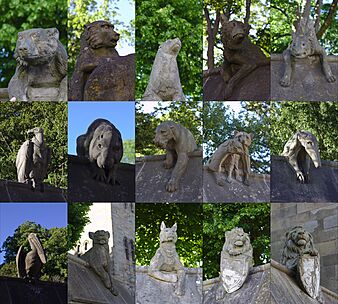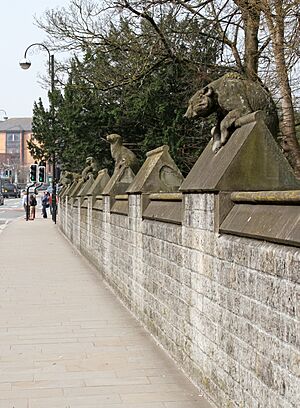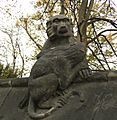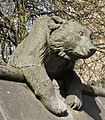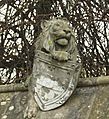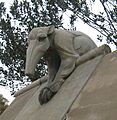Animal Wall facts for kids
Quick facts for kids Animal Wall |
|
|---|---|
| Welsh: Wal yr Anifeiliaid | |
|
|
|
| Type | Wall |
| Location | Cardiff, Wales |
| Built | 1880-1930 |
| Architect | William Burges |
| Owner | Cardiff City Council |
|
Listed Building – Grade I
|
|
| Official name: Animal Wall, and Gates near Clock Tower | |
| Designated | 2 December 1952 |
| Reference no. | 21696 |
| Lua error in Module:Location_map at line 420: attempt to index field 'wikibase' (a nil value). | |
The Animal Wall (Welsh: Wal yr Anifeiliaid) is a special wall in Cardiff, Wales. It has 14 cool animal sculptures on it! You can find it in the Castle Quarter of the city centre.
This famous wall stands near the entrance to Cardiff Castle. It was moved there in the early 1930s from its first spot. A clever architect named William Burges first thought of the design. He worked for the third Marquess of Bute in the 1860s.
The first nine animal sculptures were made by Thomas Nicholls. He was Burges's favorite sculptor. Later, when the wall was moved, six more animals were added. These new sculptures were made by Alexander Carrick. The Animal Wall is a very important historical building, known as a Grade I listed structure.
Contents
Building the Animal Wall
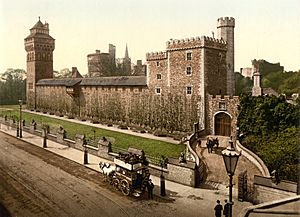
The Animal Wall was designed by William Burges in 1866. But it wasn't actually built until 1890, after Burges had passed away. Burges had big plans for a beautiful garden in front of Cardiff Castle. He wanted to fill the castle moat with flowers and grapevines.
The first nine animal figures were carved by Thomas Nicholls. He was a very skilled sculptor. These animals included a hyena, a wolf, two baboons, a seal, a bear, a lioness, a lynx, and two lions. William Frame, Burges's assistant, helped make sure the work was done.
Moving the Wall and New Animals
The Animal Wall was moved about 50 meters (164 feet) in 1922. It used to be right outside Cardiff Castle. It was moved to its current spot outside Bute Park because the roads in front of the castle needed to be made wider.
In 1931, six more animal sculptures were added to the wall. These new animals were a pelican, an anteater, two raccoons, a leopard, a beaver, and a vulture. They were carved by Alexander Carrick.
The animals even appeared in a cartoon strip in the 1930s! It was in a newspaper called the South Wales Echo. At one point, in the 1970s, there was a plan to knock down the wall. Luckily, that idea was stopped.
Restoring the Animals
The animals on the wall were first painted with natural colors. But the paint didn't last very long and was later removed.
In July 2010, a big project began to fix up the animals. This was part of a larger plan to restore Bute Park. During this repair work, the anteater's nose, which had been missing for many years, was replaced. Also, the nine original animals got their missing glass eyes back. All this work was finished in October 2010. The Animal Wall is still a very important Grade I listed structure.
Gallery
Original Animals by Thomas Nicholls (1891)
New Animals by Alexander Carrick (1931)
See also
- Grade I listed buildings in Cardiff


